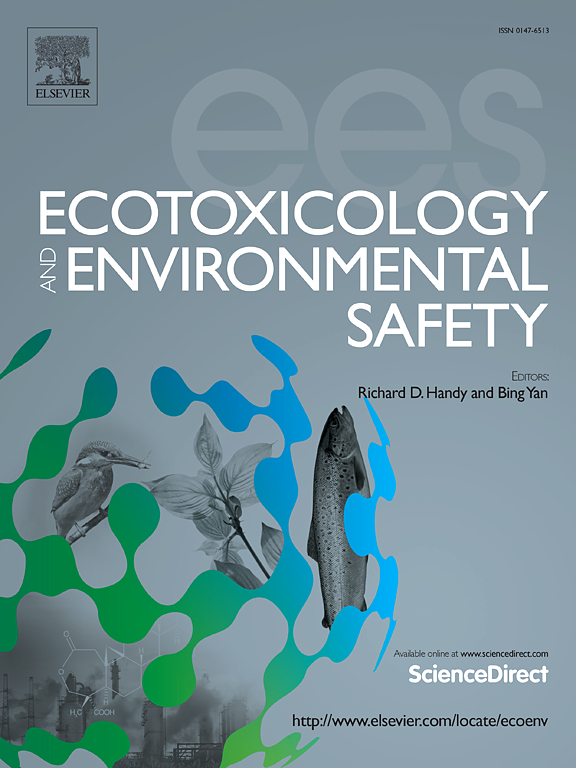胎盘加速老化介导了产前暴露于全氟烷基和多氟烷基物质与小胎龄新生儿之间的关系
IF 6.2
2区 环境科学与生态学
Q1 ENVIRONMENTAL SCIENCES
引用次数: 0
摘要
产前暴露于全氟烷基和多氟烷基物质(PFAS)是否是小胎龄(SGA)新生儿的一个危险因素尚不清楚,而胎盘过早老化在这种潜在不利影响中的作用就更少了。在对1046对母婴的分析中,从母体血清中检测了30例遗留的和新出现的PFAS。分别使用logistic回归、贝叶斯核机回归(BKMR)和基于分位数的g计算(QGC)对单一和混合效应进行分析,确定(共同)暴露于PFAS与SGA发病率之间的关系。尽管存在遗留的PFAS,但产前暴露于短链新出现的PFAS,包括全氟己烷磺酸(PFHxS,每对数10单位:OR=2.91, 95 %CI= 1.63-5.27)和全氟戊酸(PFPeA,每对数10单位:OR=3.02, 95 %CI= 1.50-6.31)与较高的SGA发生率相关。共同暴露于这些高度流行的PFAS与分娩SGA婴儿的几率增加有关,两种模型都显示新出现的PFAS PFHxS和全氟三烷酸(PFTrDA)是主要因素。此外,在1:2的病例对照中,发现SGA母亲的胎盘相对端粒长度(TL)比AGA母亲短(0.82 vs 0.99, P = 0.001),与SGA分娩呈负相关(OR: 0.33, 95 %CI: 0.14-0.76)。中介分析显示,胎盘TL分别介导了17.7 %的PFHxS暴露与SGA出生风险的关系。产前PFAS暴露,特别是短链同系物,与SGA的几率呈正相关,并且这种关系部分是由胎盘TL缩短介导的,这表明由于高PFAS暴露而导致SGA风险较高的孕妇需要有针对性的健康管理。本文章由计算机程序翻译,如有差异,请以英文原文为准。
Accelerated placental aging mediated the association between prenatal exposure to per- and polyfluoroalkyl substances and small-for-gestational age newborns
Whether prenatal exposure to per- and polyfluoroalkyl substances (PFAS) is a risk factor for small-for-gestational-age (SGA) neonates remain elusive, yet even less is known on the role of premature placental aging in this potential adverse effect. In this analysis of 1046 maternal-infant dyads, 30 legacy and emerging PFAS were measured from maternal serum. Associations between (co-)exposure to PFAS and the incidence of SGA were determined using logistic regression, Bayesian Kernal Machine Regression (BKMR) and quantile-based g-computation (QGC) for single and mixture effect, respectively. Despite the legacy PFAS, prenatal exposure to short-chain emerging PFAS, including perfluorohexane sulfonic acid (PFHxS, per log 10 unit: OR=2.91, 95 %CI=1.63–5.27) and perfluoropentanoic acid (PFPeA, per log 10 unit: OR=3.02, 95 %CI=1.50–6.31) were associated with higher SGA odds. Co-exposure to these highly prevalent PFAS were associated with increased odds of delivering SGA infants, with both models showing emerging PFAS PFHxS and perfluorotridecanoic acid (PFTrDA) being the primary contributors. Further in a 1:2 case-control setting, it was found placental relative telomere length (TL) was shorter in mothers bearing SGA than those with AGA (0.82 vs 0.99, P = 0.001), showing negative association with SGA birth (OR: 0.33, 95 %CI: 0.14–0.76). Mediation analysis revealed that placental TL mediated 17.7 % of the relationship between PFHxS exposure and the risk of SGA birth, respectively. Prenatal PFAS exposure, especially the short-chain congeners, was positively associated with the odds of SGA, and the relationship was partially mediated by shortened placental TL, indicating a need for targeted health management in pregnant mothers at higher risk of SGA due to high PFAS exposure.
求助全文
通过发布文献求助,成功后即可免费获取论文全文。
去求助
来源期刊
CiteScore
12.10
自引率
5.90%
发文量
1234
审稿时长
88 days
期刊介绍:
Ecotoxicology and Environmental Safety is a multi-disciplinary journal that focuses on understanding the exposure and effects of environmental contamination on organisms including human health. The scope of the journal covers three main themes. The topics within these themes, indicated below, include (but are not limited to) the following: Ecotoxicology、Environmental Chemistry、Environmental Safety etc.

 求助内容:
求助内容: 应助结果提醒方式:
应助结果提醒方式:


